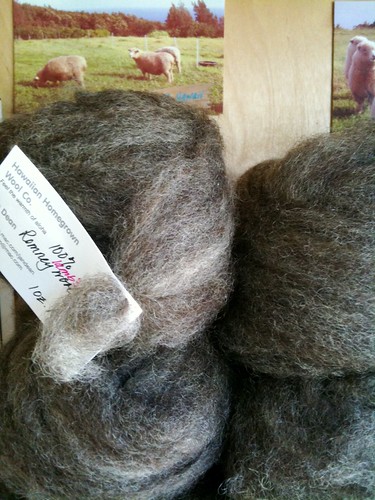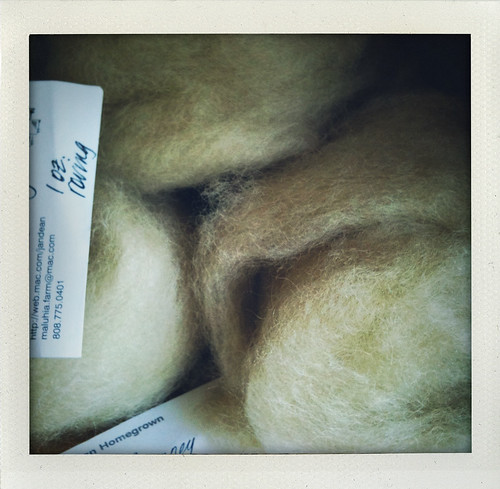How to make low-sugar lilikoi jelly using fresh fruit and Pomona's pectin
Read MoreRehydrated pomegranate rinds, ready for grinding.
Pomegranate Rind Dye | Natural Plant Dye
My parents have a pomegranate tree that produces fruit slowly and steadily, so every few weeks I add one or two more rinds to a bag in my freezer. I had a full bag, so I dried out the rinds as much as possible in direct sunlight, and then got them completely dry in the oven on the lowest setting. When I was ready to make a batch of dye, I soaked the dried rinds overnight and then blended the rehydrated rinds with the soaking water in my Vitamix blender. The resulting pulp was strained through a mesh strainer, and then strained again through a piece of muslin fabric. It's extra work, but using dried rinds does make a difference - when I did a batch with fresh rinds last year, the results were much lighter. Because of the tannin content, pomegranate rinds can also be used as a mordant, so I mixed it with a batch of mint leaf dye and a batch of lemongrass leaf dye.
Ground up pomegranate rinds, after the first straining - I had to strain it through a piece of muslin fabric to get all of the little bits you can see here out.
Photos of the dyed yarns to come! If you are interested in using pomegranate rind and mint leaf botanical dyes, The Handbook of Natural Plant Dyes by Sasha Duerr has some general information about pomegranate rind and a recipe for mint leaf dye.
Hawaiian Homegrown Wool Co.
Did you know? You can buy fleece, roving, and yarn grown and processed in Hawaii. You can buy directly from the farm at the
Hawaiian Homestead Farmers Market
on the first Saturday of the month, order online from
(home of the Hawaiian Homegrown Wool Co.) or buy ready-to-spin roving from
in Honolulu.


Lilikoi-orange muffin
A modification of the orange-cranberry muffin recipe from the Post-Punk Kitchen makes a light, fluffy, fragrant treat!
Read MoreLilikoi Lovers Passionfruit Cupcakes (Lilikoi Frosting)
Part 3 of 3 - Part 1: Cupcakes, Part 2: Lilikoi Curd
Swiss meringue/7-Minute frosting is light, fluffy, and sweet without being cloying. It also suited my purposes - I wanted something that would be sweet enough to help balance out the tart flavor of the curd without overwhelming it. Because a very specific shade of blue was requested and I didn't want to take any chances with that, I used water instead of juice and vanilla bean-scented sugar instead of vanilla extract in the frosting I made for the wedding cake and cupcakes. With only the vanilla to flavor it, the frosting is like a high grade of marshmallow fluff - smooth, shiny, and melting on the tongue. With the juice to flavor it, there is an additional layer of fragrance and flavor to dance on the tastebuds. Both are delicious! Best used the same day it is made; can be put into pastry bags [piping bags] and refrigerated for a day or two with minimal deflating. If there are leftovers, you can use them to make a pavlova: spread a layer about 1" [2.5 cm] thick on parchment paper and bake on a cookie sheet at 250 °F [120 ℃ or Gas Mark ½] for about 1 ½ hours. Turn off oven and let cool. Serve topped with lilikoi curd, whipped cream, and assorted chopped fresh fruit (I like pineapple and berries).
Lilikoi Frosting (adapted from classic 7-minute frosting - there are many recipes out there; I printed out Paula Deen's recipe from the Food Network website, used the same proportions, but changed up the instructions to be based on temperature and appearance).
One batch will frost a 9" 4-layer cake or 24 cupcakes.
2 large egg whites
1 ½ cups [165 g] granulated white sugar [UK: caster sugar works better as it will dissolve faster. US: if desired, first measure and then grind the sugar finer in a blender or food processor]
1 Tbs corn syrup [or 1/4 tsp / 1 g cream of tartar - if not available, you can leave this out; the frosting will then be less stable and should be served as soon as possible]
1/3 cup [80 mL] fresh lilikoi (passionfruit) juice (or lemon juice, or water)
pinch of salt
1 Tbs [15 mL] vanilla extract
With electric hand-held mixer, beat egg whites on low for 1 minute. Beat in remaining ingredients. In a bain-marie or double boiler, beat on high until temperature reads 140 °F [60 ℃], then continue to beat on high for 7 - 8 minutes until soft peaks will stand on the surface. Remove from heat and continue beating on low for 2 minutes. Should be fluffy, smooth, and glossy. If it begins to separate after cooling (water visible in bottom of bowl under the fluff), it is undercooked and can be re-beaten over hot water to get it completely cooked.
Update (August 2019): for those looking for a lilikoi glaze, it’s super easy:
Lilikoi Drizzle or Glaze
2 cups [8 oz or 226 g] confectioners sugar (also called icing sugar and powdered sugar - fine sugar with cornstarch)
2 - 4 Tablespoons [about 30 - 70 ml] fresh lilikoi (passionfruit) juice
Stir the lilikoi juice into the sugar a spoonful at a time, until it’s the consistency you want. For a drizzle that will sit on top of a cake, use 2 Tablespoons of juice. For a glaze that soaks into the cake, use more. I test it on a corner of a cake to see how thick or thin it is. The total amount will depend on things like how humid it is in the room you are working in and how warm the cake is. If you want the drizzle to stand up and hold its shape, make sure the cake is completely cool first!



